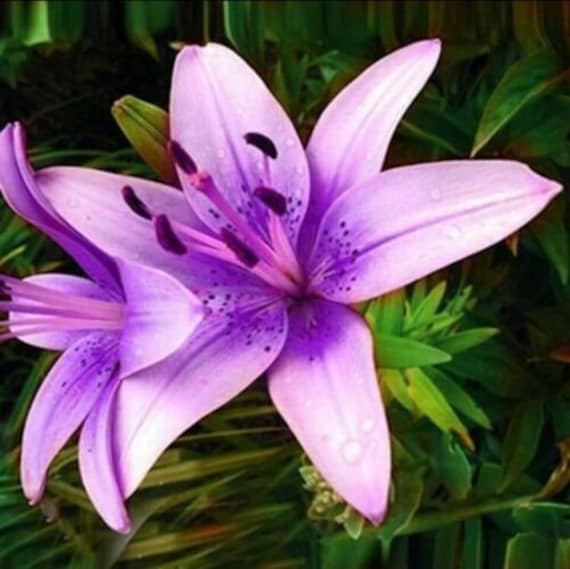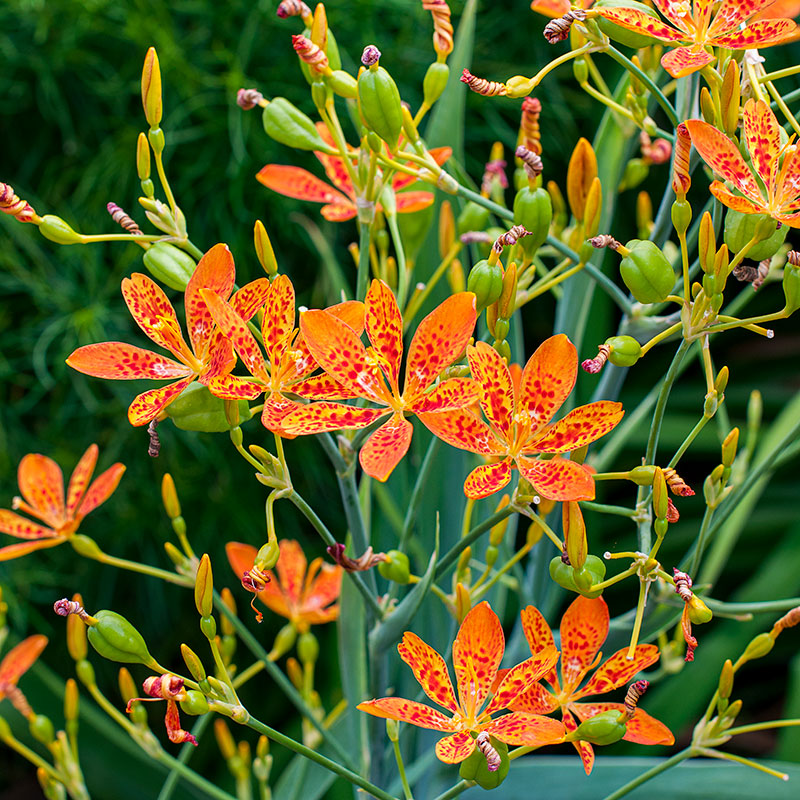How to Plant Lily Flower Seeds A Comprehensive Guide to Cultivating Lilies in Your Garden
Lilies are a beloved and enchanting addition to any garden. With their tall, slender stems and vibrant, trumpet-shaped blooms, they bring elegance and charm to any landscape. But growing lilies can be intimidating for many gardeners, especially those new to gardening. This comprehensive guide aims to equip gardeners of all experience levels with the knowledge and techniques necessary to successfully grow and enjoy lilies in their gardens.
I. Introduction

A. Overview of Lilies (Lilium species)
Lilies belong to the Liliaceae family and are a diverse group of flowering plants. They are native to temperate regions in the Northern Hemisphere, with some species found in tropical and subtropical areas. The genus Lilium includes over 100 species, with numerous hybrids and cultivars developed for ornamental purposes.
Lilies are known for their captivating beauty, graceful forms, and captivating scents. They come in a wide range of colors, sizes, and fragrances, making them versatile plants suitable for various gardening styles. Some popular lily varieties include Asiatic Lily (Lilium asiatic), Oriental Lily (Lilium oriental), Trumpet Lily (Lilium longiflorum), Daylily (Hemerocallis), Turk's Cap Lily (Lilium martagon), Martagon Lily (Lilium superbum), Easter Lily (Lilium longiflorum), Tiger Lily (Lilium lancifolium), Madonna Lily (Lilium candidum), Canadale Lily (Lilium canadense), Wood Lily (Lilium philadelphicum), California Lily (Lilium pardalinum), Fire Lily (Lilium bulbiferum), Casa Blanca Lily (Lilium 'Casa Blanca'), Black Beauty Lily (Lilium 'Black Beauty'), Stargazer Lily (Lilium 'Stargazer'), Royal Trinity Lily (Lilium regale), Rubrum Lily (Lilium speciosum var. rubrum), Henry's Lily (Lilium henryi), and Columbian Lily (Lilium columbianum).
B. Significance and Varieties of Lilies in Gardening
Lilies hold significant importance in various cultures, symbolizing purity, innocence, and love. They have been used in bouquets, floral arrangements, and decorations for special occasions for centuries. In gardening, lilies are valued for their striking appearance and versatility. They can be grown in containers, borders, or as cut flowers, making them a popular choice among gardeners.
C. Purpose of the Article: to Provide a Detailed Guide on Growing Lilies
This comprehensive guide aims to provide a step-by-step approach to growing lilies in your garden. From understanding different varieties to planting, caring, and maintaining lilies, this article offers a detailed and comprehensive guide for gardeners of all levels.
II. Understanding Lily Varieties

A. Overview of Popular Lily Types (Asiatic, Oriental, Trumpet, etc.)
Lilies are classified into several types, each with unique characteristics. The most common types include Asiatic, Oriental, Trumpet, and Daylilies. Other types include Turk's Cap Lily, Martagon Lily, Easter Lily, Tiger Lily, Madonna Lily, Canadale Lily, Wood Lily, California Lily, Fire Lily, Casa Blanca Lily, Black Beauty Lily, Stargazer Lily, Royal Trinity Lily, Rubrum Lily, Henry's Lily, and Columbian Lily.
B. Characteristics of Each Type (Color, Size, Fragrance)
Each type of lily has its own distinct characteristics, including color, size, and fragrance. Asiatic lilies are known for their bright and bold colors, ranging from yellow and orange to pink and red. They are also the earliest blooming lilies, with a wide range of sizes from dwarf varieties to tall ones.
Oriental lilies, on the other hand, have larger and more fragrant blooms compared to Asiatic lilies. They come in a variety of colors, including white, pink, and bi-colors. Trumpet lilies have large, trumpet-shaped flowers and are known for their strong fragrance. They come in shades of white, yellow, and pink.
Daylilies are not true lilies but are often grouped with them due to their similar appearance. They have a shorter blooming period but produce multiple blooms on each stem. They come in a wide range of colors, including yellow, orange, and red.
C. Selecting the Right Variety for Your Garden and Climate
When choosing lilies for your garden, it is essential to consider your climate and growing conditions. Some lily varieties thrive in cooler climates, while others prefer warmer temperatures. It is also important to consider the amount of sunlight and shade in your garden, as some lilies require full sun, while others can tolerate partial shade.
Researching and understanding the specific requirements of each lily type will help you select the right variety for your garden. Consider consulting with local gardening experts or visiting a nearby botanical garden to see which lilies grow well in your area.
III. Preparing for Planting
A. Ideal Soil Conditions for Lilies
Lilies prefer well-draining soil that is rich in organic matter. The ideal pH level for lilies is between 6.0 and 7.0. If your soil is too acidic, you can add lime to raise the pH level. On the other hand, if your soil is too alkaline, you can add sulfur to lower the pH level.
B. Sunlight and Shade Requirements
Most lilies require full sun to thrive, meaning they need at least six hours of direct sunlight per day. However, some varieties, such as Martagon lilies, can tolerate partial shade. It is essential to consider the amount of sunlight in your garden when selecting lilies for planting.
C. Considerations for Planting Location
When choosing a location for planting lilies, it is important to consider their height and potential for wind damage. Lilies with tall stems may need support or shelter from strong winds. Additionally, avoid planting lilies near trees or shrubs that may compete for nutrients and water.
IV. Planting Lily Bulbs
A. Optimal Time for Planting
The best time to plant lily bulbs is in the fall, about 6-8 weeks before the first frost. This allows the bulbs to establish roots before the ground freezes. However, you can also plant lilies in the spring, but they may not bloom until the following year.
B. Step-by-Step Guide to Planting
- Choosing Healthy Bulbs: When purchasing lily bulbs, choose ones that are firm and plump, with no signs of mold or rot. Avoid bulbs that are soft or have sprouted.
- Soil Preparation: Prepare the planting area by loosening the soil to a depth of 12-15 inches. Remove any weeds or debris and mix in compost or well-aged manure to improve soil quality.
- Correct Planting Depth and Spacing: The general rule for planting lily bulbs is to plant them at a depth three times their diameter. For example, if a bulb is 2 inches wide, it should be planted 6 inches deep. Space bulbs at least 6-8 inches apart to allow room for growth.
C. Watering Guidelines after Planting
After planting, water the bulbs thoroughly to help them establish roots. Keep the soil moist but not waterlogged. Once the ground freezes, add a layer of mulch to protect the bulbs from extreme temperatures.
V. Caring for Lily Plants

A. Watering and Moisture Requirements
Lilies require consistent moisture, especially during their growing season. Water deeply once a week, providing about 1 inch of water. However, be careful not to overwater, as lilies do not like soggy soil. During hot and dry periods, you may need to water more frequently.
B. Fertilizing: Types and Schedules
Lilies benefit from regular fertilization to promote healthy growth and blooming. Use a balanced fertilizer, such as a 10-10-10 or 5-10-10 formula, in early spring when new growth appears. You can also apply a slow-release fertilizer in the fall to provide nutrients for the following year's blooms.
C. Mulching and Its Benefits
Mulching around lily plants helps retain moisture, suppress weeds, and regulate soil temperature. Use a layer of organic mulch, such as shredded bark or compost, to a depth of 2-3 inches. Avoid placing mulch directly against the stems to prevent rotting.
D. Pruning and Deadheading
Remove spent flowers by deadheading to encourage continuous blooming and prevent the plant from using energy to produce seeds. After the blooming season, cut back the stem to the base of the plant. In the fall, remove any dead or damaged foliage to prevent diseases from overwintering.
VI. Protecting Lilies from Pests and Diseases

A. Common Pests and Diseases Affecting Lilies
Lilies are susceptible to various pests and diseases, including aphids, thrips, mites, slugs, snails, and fungal diseases like botrytis and powdery mildew. It is essential to regularly inspect your lilies for any signs of infestation or disease.
B. Preventive Measures and Treatments
To prevent pest and disease issues, keep your garden clean and free of debris. Remove any infected or damaged leaves and dispose of them properly. You can also use organic methods, such as neem oil or insecticidal soap, to control pests. For fungal diseases, use a fungicide specifically labeled for lilies.
C. Organic and Chemical Control Options
Organic options for controlling pests and diseases include using natural predators, such as ladybugs and lacewings, and using companion plants that repel pests. Chemical control options should be used as a last resort and only when necessary. Always follow the instructions on the label and wear protective gear when applying chemicals.
VII. Lily Blooming and Maintenance

A. Understanding Blooming Cycles
Lilies have different blooming cycles depending on the variety. Some lilies bloom in early summer, while others bloom in late summer or fall. Understanding the blooming cycle of your lilies will help you plan and maintain your garden accordingly.
B. Tips to Encourage Healthy Blooms
To encourage healthy blooms, make sure your lilies are getting enough sunlight and water. Deadhead spent flowers regularly, and fertilize as needed. Also, consider staking taller varieties to prevent damage from strong winds.
C. Post-Bloom Care and Maintenance
After the blooming season, allow the foliage to die back naturally. This allows the plant to store energy for next year's blooms. Once the foliage has turned yellow and withered, you can cut it back to the base of the plant. In the fall, add a layer of mulch to protect the bulbs from extreme temperatures.
VIII. Propagating Lilies

A. Methods of Propagation (Bulb Division, Scaling, etc.)
Lilies can be propagated through various methods, including bulb division and scaling. Bulb division involves separating the bulbs into smaller sections and replanting them. Scaling is a method of propagating lilies by removing and planting scales from the bulb.
B. Best Practices for Successful Propagation
To successfully propagate lilies, choose healthy and mature bulbs. Make sure to disinfect your tools before and after use to prevent the spread of diseases. Follow proper techniques and timing for each propagation method.
C. Tips for Transplanting and Sharing Lilies
Transplanting lilies should be done in the fall when the foliage has died back. Carefully dig up the bulbs and replant them in their new location. You can also share lilies with friends and family by dividing and giving away extra bulbs.
IX. Troubleshooting Common Issues

A. Addressing Issues like Non-Blooming, Drooping, or Discoloration
If your lilies are not blooming, it could be due to several reasons, such as inadequate sunlight, overcrowding, or pests and diseases. Drooping lilies may be a sign of overwatering or underwatering. Discoloration of leaves can be caused by nutrient deficiencies or diseases.
B. Solutions for Soil and Water-Related Problems
To address soil and water-related problems, make sure your lilies are planted in well-draining soil and are receiving adequate moisture. If the soil is too wet, consider adding organic matter to improve drainage. If the soil is too dry, increase watering frequency.
C. Dealing with Extreme Weather Conditions
Extreme weather conditions, such as heatwaves or heavy rain, can affect the growth and blooming of lilies. Consider providing shade or shelter during extreme heat and using mulch to retain moisture during heavy rain.
X. Conclusion
A. Recap of the Joys and Challenges of Growing Lilies
Growing lilies can be a rewarding experience, but it also comes with its challenges. Understanding the different varieties, their specific requirements, and proper care techniques will help you successfully grow these beautiful flowers in your garden.
B. Encouraging Sustainable and Enjoyable Lily Gardening
To ensure sustainable lily gardening, avoid using harmful chemicals and opt for organic methods whenever possible. Also, consider planting native lilies to support local ecosystems and wildlife.
C. Final Thoughts and Encouragement for Gardeners of All Levels
Lilies are a beautiful addition to any garden, and with the right knowledge and techniques, anyone can successfully grow them. Don't be afraid to experiment with different varieties and techniques, and remember to enjoy the process of growing and caring for these stunning flowers. Happy gardening!


Leave a comment